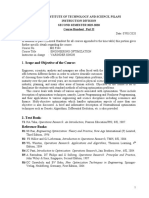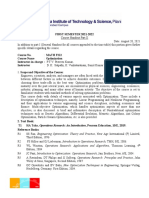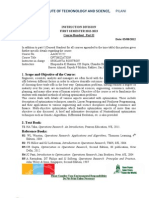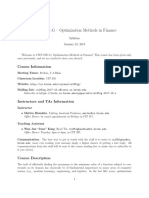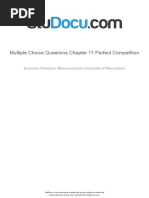Optimization
Uploaded by
Aditya PriyadarshiOptimization
Uploaded by
Aditya PriyadarshiCourse Syllabus Template
Course Code / Course Name Introduction to Optimization
Course Instructor Name(s) G. Srinivasaraghavan
Hours Component
4 Lecture (1hr = 1 credit)
Credits (L:T:P)
Tutorial (1hr = 1 credit)
(Lecture : Tutorial : Practical) Practical (2hrs = 1 credit)
L:T:P = 3-1-0 Total Credits = 4
Grading Scheme X 4-point scale (A,A-,B+,B,B-,C+,C,D,F)
(Choose by placing X against
appropriate box) Satisfactory/Unsatisfactory (S / X)
Area of Specialization (if applicable)
(Choose by placing X in box against not more than two areas from the list)
Theory and Systems for Computing Networking and
and Data Communication
Artificial Intelligence and Machine Digital Society
Learning
VLSI Systems Cyber Security
X General Elective
Programme / Branch Course is restricted to the following programmes / branch(es):
(Place X appropriately. More than one is okay)
Programme:
Branch: X CSE
X iMTech X ECE
X M.Tech Digital Society
M.Sc.
Course Category Select one from the following:
(Place X appropriately)
Basic Sciences
CSE Core
ECE Core
CSE Branch Elective
ECE Branch Elective
X Engineering Science and Skills
HSS/M
General
Course Pre-Requisites (Where applicable, state exact course code/name)
First level courses in Algorithms and Programming,
Undergraduate Mathematics with Probability, Linear
Algebra and Calculus.
Template Version 1.1
Template Date April 4, 2021
Additional Focus Areas
Select zero or more from the following and write one sentence explaining the how the focus areas covered as part of
the course.[NAAC criteria 1.1.3, 1.3.2].
Yes /
Focus Area Details
No
Direct focus on employability No
Yes Mathematical / Algorithmic /
Implementation skills required for
formulating and solving real-live
Focus on skill development optimization problems.
Focus on entrepreneurship No
Provides value added / life skills No
(language, writing, communication, etc.)
Course Context and Overview
[Provide introduction to the course]
Optimization is a fundamental ‘horizontal’ across most of the natural and engineering sciences,
computational biology, management, economics, etc. It is central to most problems involving
‘decision making’ of some sort where the intent is to take the ‘best’ decision according some
domain specific criteria. Almost all such problems are naturally modeled as optimization
problems with or without constraints. This course is meant to give a broad introduction to such
problems --- their formulation and solution strategies. The subject is mathematically intense and
course will not avoid the maths involved. However the nature of the subject makes it possible to
often visualize the algorithms while leveraging on our geometric intuition and making use of
appropriate plotting and visualization tools to provide a cushion for the abstraction in the maths.
So implementation will be an integral part of the course, including a substantial project.
Preferred implementation language will be Julia/Python. Broadly the course will focus on
‘breadth’ and not on depth. Many topics which could take a whole course for a comprehensive
discussion, will be restricted to as little as one or two lectures. The intent will be to lay the
conceptual foundations and equip the student with just enough for a deeper dive into the topic if
he/she wishes to, later. The course is expected to be of interest to a wide audience among
students across streams within IIITB.
Scope: Optimization is a very broad term and includes a wide range of algorithms and
techniques and it is not practical to do even do passing justice to all of them in a single self-
contained semester course. This edition of the course focuses largely on optimization in the
‘continuous’ world. Discrete optimization problems would include most of the well known NP-
Hard problems that have been studied extensively in computer science --- Problems on Graphs,,
Network Flow Problems, SAT Family of problems on boolean expressions, Knapsack and Bin-
packing, etc. This course excludes all of these problems, though many of these problems are
Template Version 1.1
Template Date April 4, 2021
solved using ILP methods that will be covered briefly towards the end of the course. Also the
bulk of the course is on unconstrained non-linear optimization with about one third of the course
devoted to constrained optimization --- starting with linear programming and moving on to other
non-linear constrained optimization methods. This choice was based on the following
observations (i) a number of constrained optimization problems can be transformed into
unconstrained ones, (ii) techniques for constrained optimization draw heavily on techniques
developed for unconstrained problems, and lastly (iii) unconstrained optimization for highly non-
linear problems in extremely high dimensions has received tremendous attention of late in
machine learning.
The evaluation will cover both theory and implementation / programming.
Course Outcomes and Competencies
[Course Outcomes are to be stated using appropriate terminology and taxonomy as required by NAAC
and/or NBA. For every course credit, about 2-3 outcomes are recommended. ]
PO/
Id Course Outcome
PSO
CL KC Class (Hrs)
CO1 Understand basic concepts of Optimization and PO1 U C 3
the classes of optimization algorithms P
CO2 Understand the key foundational building blocks PO1 U C 10
for optimization techniques. AP P
CO3 Understand and implement different optimization PO1 U C 32
algorithms. PO4 AP P
PSO4
CO4 Learn to formulate large real-life optimization PO1 U C
problem and implement a strategy to solve them. PO4 AP P
Legend: PO/PSO: Programme Outcomes / Programme Specific Outcomes; CL: Cognitive Level (from Revised
Bloom’s Taxonomy); KC: Knowledge Category (from Revised Bloom’s Taxonomy); Class (Hrs): Number of hours
of instruction; Tut (Hrs): Number of hours of tutorial session (where applicable)
Total Number of hours(Classes) = 45
Template Version 1.1
Template Date April 4, 2021
Concept Map of the Course (Optional)
Course Content
[Provide list-wise topics]
Instruction Schedule
[Provide session-wise schedule]
Each lecture is assumed to be of 90 mins.
Introduction and Mathematical Preliminaries
Lecture 1: Introduction to Optimization Terminology and Problem Formulation; Survey of the classes of
Optimization Techniques
Lectures 2-4: Recap of Relevant Mathematical Concepts --- Vector Spaces & Matrices, (Rank,
Independence, Transformations, Projections, Eigenvalues and Vectors, Norms, ...), Geometry
(Hyperplanes, Convexity, Polytopes), Calculus (Gradients --- uni and multi dimensional).
Gradient Computation --- Numerical Techniques, Automatic Symbolic Differentiation (this is the
backbone of all modern deep learning libraries)
Unidimensional Optimization, Bracketing
Lectures 5-7: Fibonacci Search, Golden Section Search, Quadratic Fit Search, Shubert-Piyavskii Method
(one of the few global optimization methods)
Unconstrained Optimization
Lectures 8-10: Descent Strategies --- Line Search, Trust Region Methods; Termination Criteria
Lecture 11: Newton’s Method and the Levenberg-Marquardt Variant
Lectures 12: Conjugate Gradient Methods
Lectures 13: Quasi Newton Methods
Lectures 14-15: Momentum, Nesterov Variant; Popular Optimization Algorithms in Deep Learning:
RMSProp, Adagrad, Adam, Hypergradient Descent
Global Optimization Methods
Lecture 16: Nelder-Mead Simplex Algorithm, Simulated Annealing
Evolutionary / Population-based Methods for Unconstrained Optimization
Lecture 19: Genetic Algorithms
Lecture 20: Ant-Colony Optimization, Particle Swarm Optimization
Lecture 21: Other methods - Differential Evolution, Firefly Algorithm, Cuckoo Search
Optimization Under Constraints
Template Version 1.1
Template Date April 4, 2021
Lectures 22-23: Dealing with Constraints --- Transformations to Remove Constraints, Lagrange and
Augmented Lagrange Methods --- KKT Conditions, Duality, Interior Point Methods, Other Penalty-based
Methods
Lectures 24-25: Linear Programming --- Simplex Method
Lectures 26-27: Brief Introduction to ILP (Integer Linear Programs) – Unimodular Matrices , Cutting
Plane Methods
Lectures 28-29: Introduction to Convex Optimization and Semi-Definite Programming
Other Possible Topics
These would be taken up depending on the time available --- possibly through student presentations.
Stochastic Methods
Multi-objective Optimization
Multi-disciplinary Optimization
Optimization Under Uncertainty
Surrogate Optimization
Learning Resources
[Mention text books, reference books and other learning resources required as part of the course]
1. Algorithms for Optimization by Mykel J. Kochenderfer and Tim A. Wheeler, The
MIT Press, 2019.
2. An Introduction to Optimization (4th Edition) by Edwin K.P. Chong and Stanislaw
H. Zak, Wiley, 2013.
3. Numerical Optimization (2nd Edition) by Jorge Nocedal and Stephen J. Wright,
Springer, 2006.
4. Optimization for Machine Learning, Ed by Suvrit Sra, Sebastian Nowozin and
Stephen J. Wright, The MIT Press, 2012.
5. For some project ideas: https://aa222.stanford.edu/projects/past-final-projects/ ,
https://www.cs.cmu.edu/~pradeepr/convexopt/past_projects.html ,
http://www.optimisationintherealworld.co.uk/
6. Sources for Benchmark Functions and Datasets:
https://www.sfu.ca/~ssurjano/index.html;
http://infinity77.net/go_2021/scipy_test_functions.html
Template Version 1.1
Template Date April 4, 2021
Assessment Plan
[List grade distribution in terms of % across multiple assessment types (assignments, quizzes, mid-term,
end-term, project, etc.)]
Final grade will be based on weights given below:
30%: Project
30%: Implementation Assignments
20%: Mid-Term Exam (Theory)
20%: End-Term Exam (Theory)
Assignments / Projects
[List exact number of assignments or projects included (provide generic description)]
These are intended to be naive implementations of the algorithms discussed in the course, to give students
a more hands-on feel for the algorithms. It will also give them an appreciation of what it takes for the
implementations to be ‘industry grade’ like the ones in the standard libraries (commercial or otherwise)
that are available. The focus will be on ground-up implementations with minimal use of ready-made
libraries, and the correctness / asymptotic behavior of the implementations. Edge cases, numerical
stability issues and performance considerations will be minimal, if at all.
Projects and Assignments are expected to done in small groups (pairs preferably).
S. No. Focus of Assignment / Project CO Mapping
1 Each group is expected to implement and demonstrate CO1-3
in the class a minimum number from among the
algorithms discussed in the class
2 Each group is expected to pick a project topic at the CO4-8
beginning of the course and work on it through the
semester. Projects presentations will be done at the end
of the semester.
Late Assignment Submission Policy
State any penalty policy for late submission
Unless medically approved excuse, all late submissions are not considered for grading.
Make-up Exam/Submission Policy
State if any specific policy derived from institute policy is applicable. Otherwise leave it as given
As per institute policy
Citation Policy for Papers (if applicable)
[If course includes reading papers and citing them as part of activities, state the citation policy. Mention
“Not applicable” if section is not applicable to the course]
Template Version 1.1
Template Date April 4, 2021
Academic Dishonesty/Plagiarism
State if any specific policy derived from institute policy is applicable. Otherwise leave it as given
As per institute policy
Accommodation of Divyangs
[State any enabling mechanisms for accommodating learners with special needs]
As per institute policy
Template Version 1.1
Template Date April 4, 2021
You might also like
- How To Integrate Literacy and Numeracy Skills in92% (13)How To Integrate Literacy and Numeracy Skills in26 pages
- Cell Structure (Grade 6) - Free Printable Tests and Worksheets PDF90% (10)Cell Structure (Grade 6) - Free Printable Tests and Worksheets PDF2 pages
- Airlines Reservation System Analysis and Design40% (5)Airlines Reservation System Analysis and Design30 pages
- ME F320 ENGINEERING OPTIMIZATION_HANDOUTNo ratings yetME F320 ENGINEERING OPTIMIZATION_HANDOUT2 pages
- 7 ME F344 Engineering Optimization AKGuptaNo ratings yet7 ME F344 Engineering Optimization AKGupta2 pages
- Bmee211l Engineering-Optimization TH 1.0 67 Bmee211lNo ratings yetBmee211l Engineering-Optimization TH 1.0 67 Bmee211l2 pages
- Optimization Handout AAOC222 Sem1 2012 13No ratings yetOptimization Handout AAOC222 Sem1 2012 133 pages
- Powell Modern Approach To Teaching Optimization Submitted November 9 2023No ratings yetPowell Modern Approach To Teaching Optimization Submitted November 9 202393 pages
- TMA947 Nonlinear Optimisation, 7.5 Credits MMG621 Nonlinear Optimisation, 7.5 CreditsNo ratings yetTMA947 Nonlinear Optimisation, 7.5 Credits MMG621 Nonlinear Optimisation, 7.5 Credits7 pages
- Optimization: Optimization: The Procedure or Procedures Used To Make A System or Design As Effective orNo ratings yetOptimization: Optimization: The Procedure or Procedures Used To Make A System or Design As Effective or8 pages
- Pilani Pilani Campus: Birla Institute of Techonology and ScienceNo ratings yetPilani Pilani Campus: Birla Institute of Techonology and Science4 pages
- Engineering, 2nd Edition, Cambridge University Press, 2013.: Topics Lectures T / R (Chapter)No ratings yetEngineering, 2nd Edition, Cambridge University Press, 2013.: Topics Lectures T / R (Chapter)2 pages
- Math336-Mathematical Optimization: DescriptionNo ratings yetMath336-Mathematical Optimization: Description2 pages
- PE 6222 Optimization for Engineering DesignNo ratings yetPE 6222 Optimization for Engineering Design4 pages
- 49.CHE2035IU - Simulation and Optimization - LabNo ratings yet49.CHE2035IU - Simulation and Optimization - Lab7 pages
- Non Linear Optimization in EENG Lecture - 00No ratings yetNon Linear Optimization in EENG Lecture - 0018 pages
- Optimization Tools: Constraint Programming SolversNo ratings yetOptimization Tools: Constraint Programming Solvers2 pages
- UUM 526 Optimization Techniques in Engineering Spring 2018-2019No ratings yetUUM 526 Optimization Techniques in Engineering Spring 2018-20193 pages
- Project-Structured Assignment-Guidelines-ESS 102 Digital DesignNo ratings yetProject-Structured Assignment-Guidelines-ESS 102 Digital Design1 page
- English Sheet Test 3, 5 & 9 10.04.25 Home WorkNo ratings yetEnglish Sheet Test 3, 5 & 9 10.04.25 Home Work5 pages
- Practical Guide To Evil Jumpchain UpdatedNo ratings yetPractical Guide To Evil Jumpchain Updated15 pages
- Yale j813gp-glp-gdp110vx Lift Truck Service Repair ManualNo ratings yetYale j813gp-glp-gdp110vx Lift Truck Service Repair Manual57 pages
- Maratha Mandir Babasaheb Gawade Institution of Management Studies Mms Semester Ii Subject - Analysis of Financial StatementNo ratings yetMaratha Mandir Babasaheb Gawade Institution of Management Studies Mms Semester Ii Subject - Analysis of Financial Statement9 pages
- Software Engineering: User Interface DesignNo ratings yetSoftware Engineering: User Interface Design14 pages
- Different Kinds of Drugs and Its EffectsNo ratings yetDifferent Kinds of Drugs and Its Effects13 pages
- The Colonial Origin of The Social SciencesNo ratings yetThe Colonial Origin of The Social Sciences5 pages
- Contingency Perspectives of Organizational Strategy - A Critical Review of The Empirical ResearchNo ratings yetContingency Perspectives of Organizational Strategy - A Critical Review of The Empirical Research15 pages
- Multiple Choice Questions Chapter 11 Perfect CompetitionNo ratings yetMultiple Choice Questions Chapter 11 Perfect Competition26 pages
- Cell Structure (Grade 6) - Free Printable Tests and Worksheets PDFCell Structure (Grade 6) - Free Printable Tests and Worksheets PDF
- Bmee211l Engineering-Optimization TH 1.0 67 Bmee211lBmee211l Engineering-Optimization TH 1.0 67 Bmee211l
- Powell Modern Approach To Teaching Optimization Submitted November 9 2023Powell Modern Approach To Teaching Optimization Submitted November 9 2023
- TMA947 Nonlinear Optimisation, 7.5 Credits MMG621 Nonlinear Optimisation, 7.5 CreditsTMA947 Nonlinear Optimisation, 7.5 Credits MMG621 Nonlinear Optimisation, 7.5 Credits
- Optimization: Optimization: The Procedure or Procedures Used To Make A System or Design As Effective orOptimization: Optimization: The Procedure or Procedures Used To Make A System or Design As Effective or
- Pilani Pilani Campus: Birla Institute of Techonology and SciencePilani Pilani Campus: Birla Institute of Techonology and Science
- Engineering, 2nd Edition, Cambridge University Press, 2013.: Topics Lectures T / R (Chapter)Engineering, 2nd Edition, Cambridge University Press, 2013.: Topics Lectures T / R (Chapter)
- Optimization Tools: Constraint Programming SolversOptimization Tools: Constraint Programming Solvers
- UUM 526 Optimization Techniques in Engineering Spring 2018-2019UUM 526 Optimization Techniques in Engineering Spring 2018-2019
- Project-Structured Assignment-Guidelines-ESS 102 Digital DesignProject-Structured Assignment-Guidelines-ESS 102 Digital Design
- Yale j813gp-glp-gdp110vx Lift Truck Service Repair ManualYale j813gp-glp-gdp110vx Lift Truck Service Repair Manual
- Maratha Mandir Babasaheb Gawade Institution of Management Studies Mms Semester Ii Subject - Analysis of Financial StatementMaratha Mandir Babasaheb Gawade Institution of Management Studies Mms Semester Ii Subject - Analysis of Financial Statement
- Contingency Perspectives of Organizational Strategy - A Critical Review of The Empirical ResearchContingency Perspectives of Organizational Strategy - A Critical Review of The Empirical Research
- Multiple Choice Questions Chapter 11 Perfect CompetitionMultiple Choice Questions Chapter 11 Perfect Competition








